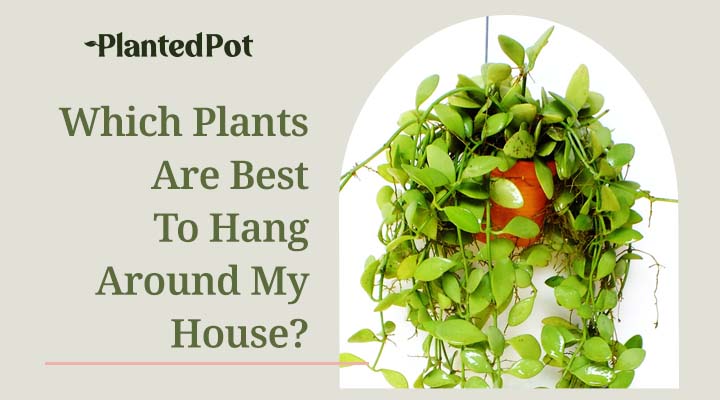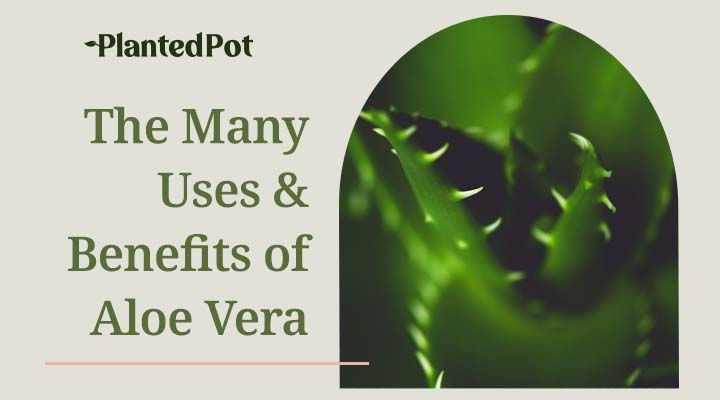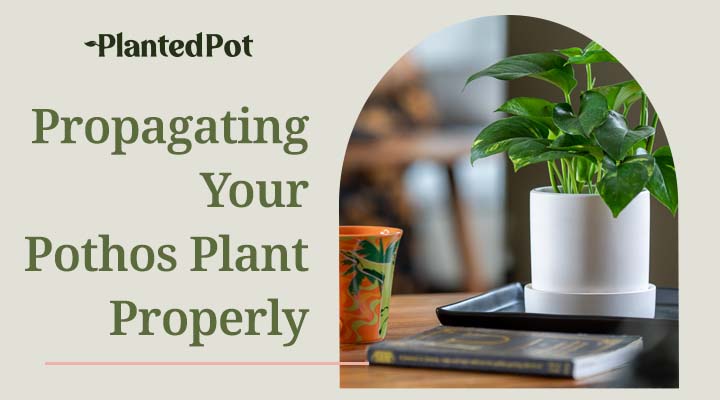
String of Dolphins Care Guide and Fun Facts
Home / String of Dolphins Care Guide and Fun Facts
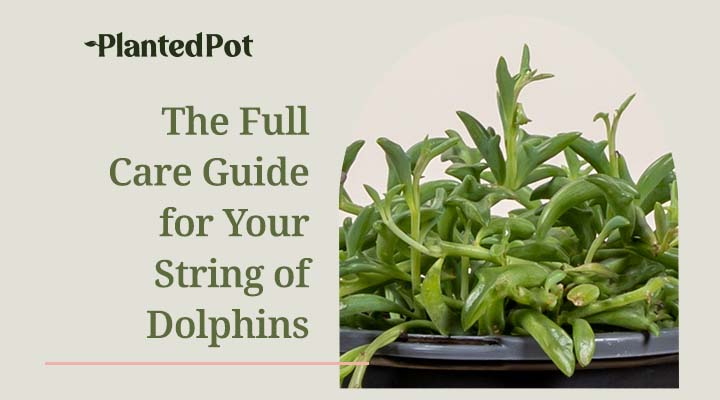
String of Dolphins Care Guide and Fun Facts
- Zephyr Jaeger
- April 6, 2021
- 10:54 pm
- No Comments
The String of Dolphins may just be the most adorable house plant you’ll ever come across. The lush little leaves on this succulent variety perfectly resemble tiny, leaping dolphins — and they’re not always easy to come by! Everyone who discovers these majestic plants is immediately enchanted, but what goes into String of Dolphins care?
Because of their rare beauty and relatively easy care routine, the String of Dolphins plant is usually in high demand. Thankfully, you can get one right here at Planted Pot! Plus, this article will fill you in on all of the best professional String of Dolphins care tips.
What is a String of Dolphins Plant?
The String of Dolphins plant is a crossbreed of two other succulent varieties: Senecio articulatus (known as the Candle Plant or Hot Dog Cactus) and Senecio rowleyanus (String of Pearls). Hot Dog Cacti grow unique formations of stubby, sausage-like stems. String of Pearls have long, delicate, draping stems adorned with numerous small, pearl-shaped growths.
When the String of Pearls was crossed with the Hot Dog Cactus, it yielded uniquely beautiful, dolphin-shaped leaves. These leaves are stunning and unique, wholly unlike anything seen on other popular houseplants like the Calathea Rattlesnake. It’s as if the long, stubby stem genetics from the Hot Dog Cactus simply elongated and added fringes to the String of Pearls’ spherical growths. Thanks to this match made in heaven, the String of Dolphins is truly a wonder.
Also called the Dolphin Plant, the String of Dolphins’ scientific name is Senecio peregrinus. Its exact origins are elusive and mysterious; some believe it was naturally cross-pollinated in nature, while others think humans intentionally crossbred it. Which one is true? We’ll likely never know.
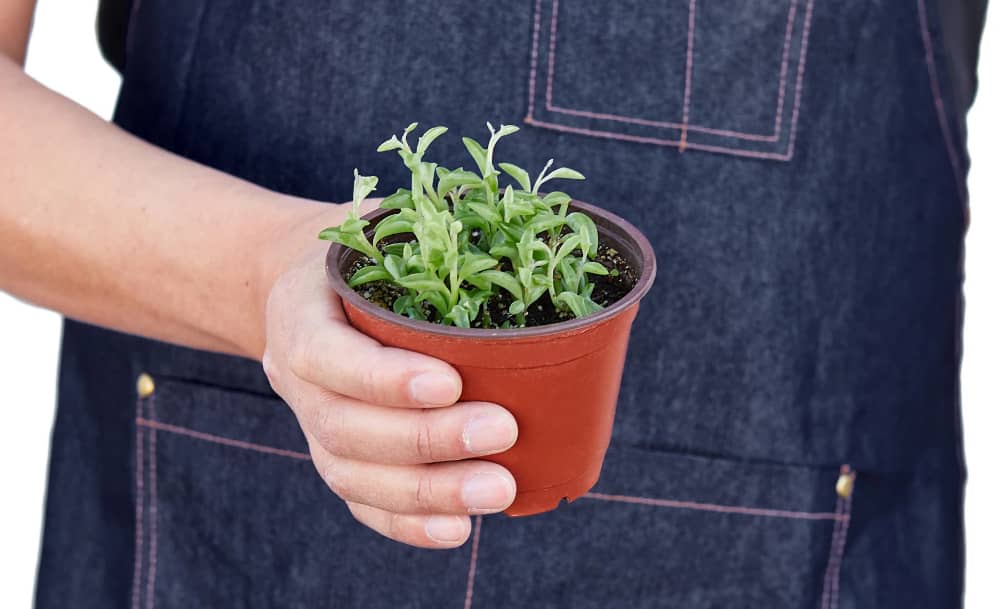
Are String of Dolphins Plants Easy to Care For?
Like many other succulents, the String of Dolphins is fairly easy to care for. The String of Dolphins is typically able to withstand lower temperatures than many of its succulent family members. However, since it’s a rare plant, many String of Dolphins owners pay extra close attention to these plants out of love.
With the proper watering schedule, the correct amount of light, and the occasional repotting, you shouldn’t have any trouble caring for a String of Dolphins. Succulents are notoriously hardy plants, although the String of Dolphins is technically a “soft” succulent.
“Hard” succulents originate in regions that experience cold temperatures, meaning they can tolerate cold drafts or drastic temperature changes. Soft succulents, on the other hand, are native to warm climates. This means they are a bit more sensitive to chilly weather. They just need a loving touch!
Can You Grow a String of Dolphins Plant Indoors and Outdoors?
You can grow String of Dolphins inside and outside, although it’s easier to control their environment indoors. Dolphin Plants are commonly grown in hardiness zone 10, meaning they can withstand outdoor temperatures as low as 35°F. Use caution since these are soft succulents that cannot withstand frost.
String of Dolphins prefer warmth and moderate brightness but can burn in too much direct sunlight. If you’re going to grow a Dolphin Plant outdoors, be sure to find a shady spot where it can receive bright yet indirect light. Indoor growing is much, much easier with the String of Dolphins plant.
What Are the Benefits of a String of Dolphins Plant?
Whether you have an all-mighty green thumb or can’t seem to keep a plant alive, the String of Dolphins is an easy, uniquely gorgeous plant to add to your home. Friends and family will be in awe of the delightful “pod of flying dolphins” growing on the tendrils that hang down from your pot.
In addition to being a conversation starter, succulents are an excellent way for beginner plant owners to learn about basic plant care. The String of Dolphins is a somewhat delicate yet still classically resilient succulent, so working to keep it healthy and happy will teach you some fantastic plant care skills.
In addition to beautifying your home and teaching you proper plant responsibility, succulents like the String of Dolphins are splendid air-purifying plants! You give them light and water, and they thank you by filtering out certain household toxins. It’s a lovely symbiotic relationship.
String of Dolphins Plant Care Tips
In this next section, we will go over the best care tips for String of Dolphins plants. Although they’re generally easy plants, there are a few tricks to keeping your Dolphin Plant happy, healthy, and thriving for years. Like the leaves on your Dolphin Plant, let’s dive in!
Choosing the Right Soil
Choosing the right soil is essential for all plants, especially for succulents requiring special conditions. The Senecio peregrinus needs a well-draining soil mix intended for succulents and cacti. If your soil doesn’t allow water to pass through it easily, your Dolphin Plant may be prone to root rot from retaining water.
Finding the Right Pot
It may seem strange, but the Dolphin Succulent enjoys slightly crowded spaces. With many common houseplants, a good rule of thumb is to look for a pot that is 1/3 the size of the plant. With a String of Dolphins plant, look for a pot that is only just big enough to fit the roots inside (it should be snug but not squished).
Additionally, to ensure proper drainage and soil moisture levels, look for a porous pot with drainage holes at the bottom. Terracotta and other clay pots tend to be the best for plants like the Dolphin Succulent.
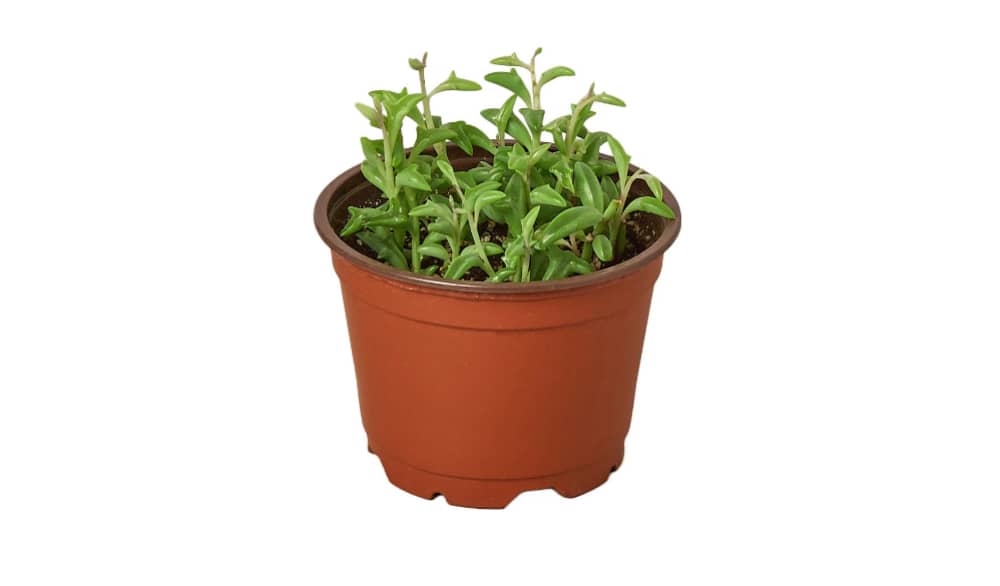
Watering Your String of Dolphins Plant
One of the biggest succulent struggles can be accidentally overwatering them. However, that’s typically less of an issue with the String of Dolphins. The Senecio peregrinus enjoys moderately damp but not drenched soil — watering about once a week is generally the perfect amount.
During its growing season (Spring/Summer), slowly soak your Dolphin Plant’s soil evenly until water drips from the drainage holes. Then, allow a few minutes for excess water to flow out. If you allow the fluids to drain into a tray, be sure to dump the excess water after 10 minutes to avoid the plant reabsorbing it.
Before watering again, allow your Dolphin Plant’s soil to get fairly dry. It shouldn’t be completely dry, but it shouldn’t feel damp, either. Most of the time, it takes about a week for the String of Dolphins’ soil to dry, but it isn’t always on a perfect schedule.
During the String of Dolphins’ dormant period (late Fall/Winter), reduce watering to about once a month. Since it isn’t actively growing, it doesn’t need as much water to thrive during this time.
Feeding Your String of Dolphins
The String of Dolphins plant doesn’t need much fertilizer. To encourage healthy growth, you can give it half-strength liquid fertilizer or fertilizer pellets once a year at the beginning of its growing season in the Spring.
String of Dolphins Placement and Lighting
When grown indoors, Dolphin Plants need about six hours of sunlight per day. South-facing windows are the best places for these plants — they allow a good amount of bright morning light but not too much direct sunlight throughout the day. West-facing windows are also an okay location.
When grown outdoors, choose a shady spot nearby other plants. Remember, the String of Dolphins likes to be slightly crowded and cannot handle too much direct sunlight. As long as they’re in a spot where they’ll get indirect, filtered light, your outdoor String of Dolphins should do just fine.
Humidity and Temperature for the String of Dolphins
String of Dolphins plants thrive in temperatures between 65 and 72°F. They can withstand cooler temperatures than some other soft succulents, but cold drafts can still be damaging to them. Do your best to place them away from air conditioners, vents, and unsealed windows during the winter months.
An average household humidity of ~40% is perfect for Dolphin Plants. If the humidity goes above 50%, they may become oversaturated with water and begin to droop. If you’re not sure what the humidity levels in your home are, monitors like these can be a huge help!
Pruning a String of Dolphins Plant
If any leaves or stems on your Dolphin Plant turn yellow or brown, it’s best to prune them to encourage healthy regrowth. Using a clean, sharp pair of shears or scissors, make clean cuts that completely remove all yellowing stems/leaves.
You can also use the same practice to cut off healthy stems to propagate more String of Dolphins plants. Grow more for your collection or give the cuttings/young plants to friends as a rare and unique living gift!
Common Issues Found in a String of Dolphins Plant
You’d think that String of Dolphins would be too cute and innocent for problems. Alas, it has issues just like the rest of us. There are a few common pests and plant care concerns that may crop up for Dolphin Plants.
Pests
Spider mites and mealybugs are common Dolphin Plant pests. Spider mites can be identified by the little webs they spin underneath leaves, and mealybugs present as cottony-white growths. To remove mealybugs, rub the affected area with a rubbing alcohol-soaked cotton swab.
Spider mites are a bit trickier to get rid of. One of the best ways to remove these pests is to bring your Dolphin Plant outdoors and gently spray it with cool water. If either pest problem persists, we recommend trying insecticidal soap.
Root Rot / Leaf Rot
As we mentioned, overwatering is a common cause of succulent sickness and death. If you notice your String of Dolphins’ leaves becoming mushy, droopy, or translucent, it’s likely getting too much water. This can also affect the roots, causing them to turn brown or black and potentially grow fungi (root rot).
How Do I Know if My String of Dolphins is Dying?
If your String of Dolphins plant begins to droop, turn brown or yellow, drop leaves, or shrivel, it may be dying. Untreated pests can also cause a Dolphin Plant to perish. Do your best to remedy pests and avoid over/underwatering before it becomes a larger issue that may be harder to control.
Are String of Dolphins Plants Poisonous?
Although there are conflicting reports, most sources indicate that the String of Dolphins is toxic to cats and dogs. Some sources claim that String of Dolphins is safe for pets, but some toxicity has been found in other Senecio plants. String of Dolphins may also be mildly toxic to humans, so we recommend you play it safe and keep the plant away from any little rascals you have running around. Check out our article on pet friendly plants if you’d like to learn more.
Final Thoughts – String of Dolphins Care
The String of Dolphins is a delightful, sought-after, aquatic-themed houseplant. If you’re lucky enough to find one, don’t let it pass you by! These rare beauties bring unique, charming elegance to wherever they’re adopted or grown.


